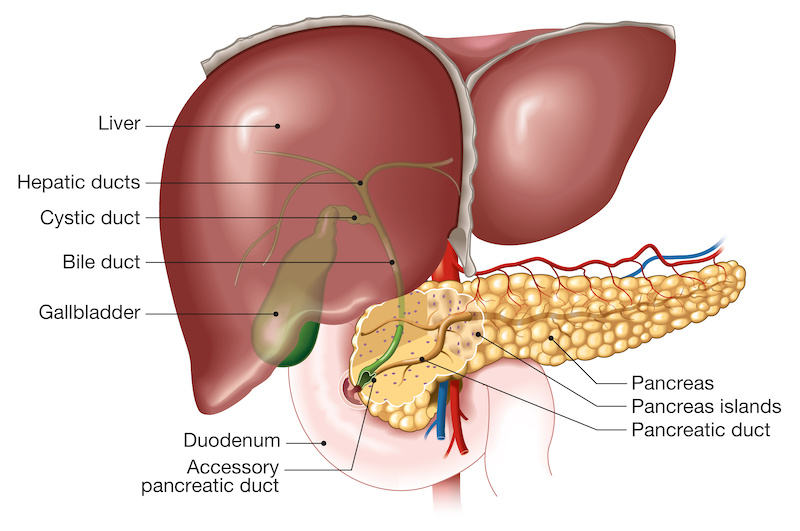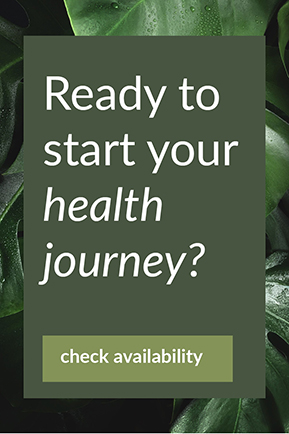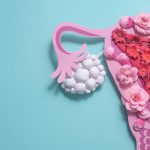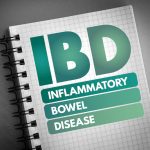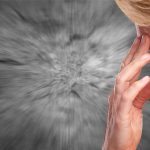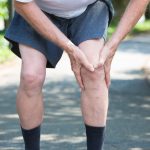The gallbladder is one of the unsung heroes of the digestive system and is an organ that is often overlooked when it comes to digestive health. Our modern Western diet greatly impacts gallbladder health, leading to problems such as gallstones, an issue that affects up to 30% of Australians over 50. Here we look at the role of the gallbladder in health and disease and learn some of the diet and lifestyle changes that can help to support a healthy gallbladder and overall digestive health.
What is the Gallbladder?
The gallbladder is a small, pear-shaped organ that lies attached to the underside of the liver. The gallbladder’s primary function is to store and concentrate bile, a fluid produced by the liver, and to release bile into the small intestine during digestion. Because of their shared role in the production and secretion of bile, the function and health of the gallbladder is closely linked to that of the liver, and many of the common health issues of the gallbladder are related to (or worsened by) poor liver function and particularly altered bile secretion.
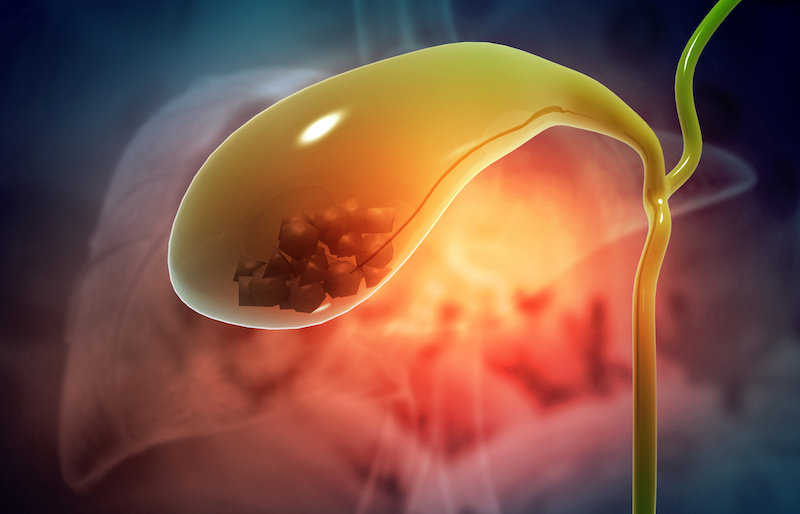
What is Bile and How is it Made?
Bile is one of our “digestive juices”, a fluid substance that is secreted by the body to facilitate digestion and absorption of vital nutrients. Bile is the primary digestive juice used for digesting and absorbing fats and the fat-soluble vitamins A, E, D, and K. It is typically a dark green to yellow colour and has a thick, sticky texture. It is made up of a mixture of water and various dissolved solids, including bile salts, cholesterol, enzymes, and even waste products ready to be excreted, such as bilirubin (a by-product of red blood cell metabolism). Bile salts are one of the key components of bile. They are produced by the liver from cholesterol via a process known as oxidation.
The human body produces around 1 litre of bile per day. Around 90% of bile is transferred to the gallbladder for storage and concentration, while the remaining 10% is deposited directly into the small intestine from the liver. Just before we start a meal, our bodies enter the cephalic phase of digestion, which is where our bodies become primed for digestion – the onset of salivating is an indicator that your body has entered this phase. It is during this phase that neural pathways signal to the pancreas to produce a hormone called cholecystokinin. This hormone stimulates the gallbladder to start contracting, releasing bile into the small intestine. Bile salts are very efficiently reabsorbed by our intestinal cells and are then transported back to the liver for reuse. About 95% of bile salts are reabsorbed, with the remainder being excreted through the bowels. This recycling of bile salts occurs 6 to 8 times a day, every day, and is known as enterohepatic recycling.
Bile, and particularly the bile salts, are vital for the absorption of fat and fat-soluble vitamins. They emulsify fats so that they can be absorbed, acting like a kind of detergent to break larger fat molecules into smaller droplets. These droplets can then be broken down by enzymes in the intestine, and ultimately absorbed through the gut wall. We know that fats are vital to good health, being used for everything from cell walls to hormones, so it is no wonder that having liver and gallbladder issues can so greatly impact how we feel.
In addition to helping with fat digestion and absorption, bile has other important functions for the body, including:
- Elimination of metabolic waste products and toxins, including bilirubin, heavy metals (lead, mercury and arsenic), drugs and medications, hormones, and chemicals
- Helps to neutralise excess stomach acid in the small intestine, preventing symptoms like heartburn and damage to the intestinal wall
- Helps to kill certain harmful bacteria in the gut, while promoting the growth of beneficial bacteria
Bile and the Gut Microbiota
You may be surprised to learn that bile and the gut microbiota are closely linked, and have a relationship that influences digestion, liver function, and even our immune system. Bile acids act like a modulator of gut bacteria, helping to keep the balance of good bacteria over bad. Special enzymes in certain good gut bacteria can metabolise bile acids. Healthy bile flow promotes higher levels of these bile-metabolising bacteria because they use bile acids as a food source with bile acids also inhibiting the growth of other, harmful types of bacteria. The emulsifying, detergent-like activity of bile acids damages the cell walls of certain bacteria species, keeping population sizes of these harmful bacteria in check.
Health Conditions of the Gallbladder
Gallbladder conditions are increasingly common and can often be related to our modern Western diet and lifestyle.
Gallstones
Gallstones (AKA cholelithiasis), are a very common health issue, affecting up to 30% of Australians over the age of 50. The “stones” in gallstones are formed when bile sits stagnant in the gallbladder, allowing for crystallisation of bile salts. People with high cholesterol are particularly susceptible to gallstones. This is because 90% of gallstones are made of cholesterol. If the liver excretes too much cholesterol into bile it becomes supersaturated, making it much more likely for crystals to form. These crystals bind together to form larger stones which can become lodged in the gallbladder.
Obesity, even when otherwise metabolically healthy, increases the risk of gallstones. Other risk factors for developing gallstones include:
- Being aged over 40
- Being female
- Being overweight, or experiencing a rapid shift in weight (either gaining or losing)
- Having insulin resistance, type 2 diabetes, or metabolic syndrome – insulin increases the production of cholesterol in the liver
- Eating a diet high in calories and high in carbohydrates
- Eating a low fibre diet
- Having liver disease
Gallstones are asymptomatic in the majority of cases, but some people will experience symptoms such as intermittent bloating, pressure, or pain in the upper right abdominal area, particularly after eating fatty foods. This intermittent pain can indicate that a stone may be lodged in the neck of the gallbladder.
Cholecystitis – gallbladder inflammation
If the ducts of the gallbladder become blocked due to gallstones, inflammation (known as cholecystitis) can occur. This inflammation can be acute or chronic, and typically includes symptoms such as abdominal pain, nausea, and fever. When symptoms are sudden and severe, it is considered acute cholecystitis. This almost always indicates that the person has gallstones. Chronic cholecystitis, on the other hand, lasts for much longer and is less severe, but may have periods of acute inflammation and pain (known as biliary colic).
Biliary Insufficiency and Poor Liver Health
Whilst not directly related to the gallbladder, insufficient bile production by the liver can produce similar health issues. Signs that you may not be producing enough bile include:
- Pale stools
- Flatulence and diarrhoea
- Floating, foul smelling stools
- Heartburn (due to lack of alkalising effect of bile salts on stomach acid)
- Symptoms are worse after fatty meals
Bile is an important means of eliminating harmful toxins from the body, so insufficient production can lead to issues with many other health conditions, including menstrual condition like PMS and endometriosis that can be affected by hormone levels.
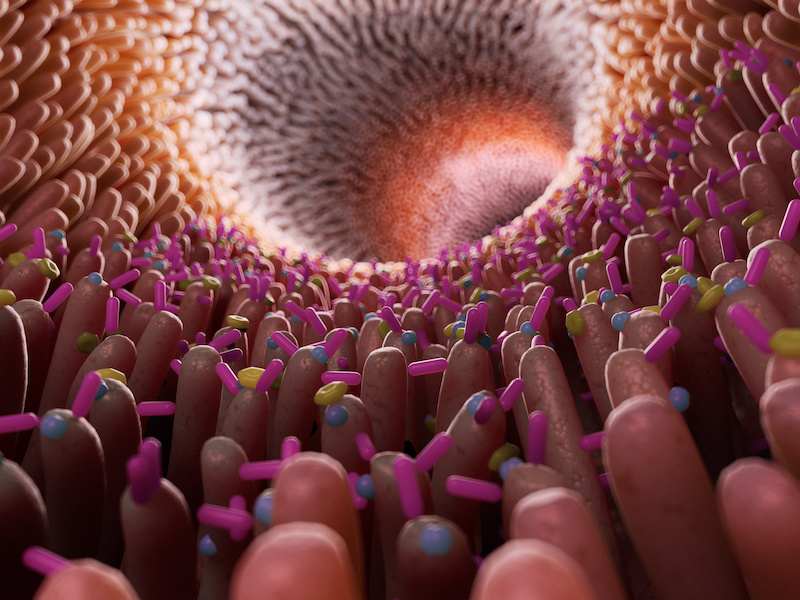
Testing
If gallstones or inflammation are expected, you may be referred for an ultrasound, as well as liver function tests. Naturopaths often refer you for additional testing, including cholesterol, insulin, and a hormone profile, too. These additional tests can help to uncover what is happening with your health and can unlock information about underlying drivers of your condition, so that an effective treatment strategy can be made for you.
Supporting a Healthy Gallbladder
Treatment of gallbladder issues is always a long-term strategy – there are no quick fixes when it comes to gallbladder health! Likewise, prevention of gallbladder conditions also requires long term healthy lifestyle strategies. Naturopathically, treatment strategies for gallbladder conditions almost always include support for the liver, and it’s easy to see why – the two organs are so closely linked both physically and functionally, so when one isn’t working well, the other also suffers.
Medical treatment of gallbladder issues is often focused on removal of the gallbladder once pain becomes unmanageable. The treatment strategies in this section are instead focused on improving your liver and gallbladder function before reaching this point in your condition. But if you have already had your gallbladder removed, read on – there is a section with tips for optimising health post-gallbladder removal below.
Diet and Lifestyle Strategies
Eat Plenty of Fibre-Rich Foods
Fibre-rich foods are so vital for good health for so many reasons, including for gallbladder health. Insoluble fibre, found in foods such as oats and wheat bran, have been found to reduce the level of cholesterol found in bile, which in turn helps to reduce the formation of cholesterol crystals and stones.
Reduce Saturated and Trans-Fat Intake
Saturated and trans fats have been shown to increase the risk of developing gallstones, so saturated fats should be reduced and trans fats eliminated altogether from the diet.
- Choose lean cuts of meat to reduce your intake of saturated fat
- Eliminate foods that contain trans fatty acids, such as margarine, deep fried foods, commercially baked products like cakes and pastries, and frozen potato products such as chips and potato “gems”
Reduce Intake of Refined Sugar
High intake of refined sugars and carbohydrates increases insulin levels, which prompts the liver to produce extra cholesterol. Excess refined sugar intake has been shown to significantly increase the risk of developing symptomatic gallstones, so should be eliminated from the diet.
When eliminating refined sugar from the diet, be aware that sugar goes by many names! Here are just some of the names you might find on the ingredients list of packaged foods and drinks: sugar, table sugar, white sugar, granulated sugar, brown sugar, raw sugar, syrup, molasses, agave syrup, honey, barley malt, malt syrup. And there are so many more! Always read food labels and choose options that don’t have added sugars and sweeteners.
Don’t Skip Meals
Eat regular, healthy meals and avoid skipping main meals. Fasting can increase the risk of gallstones, as bile sits stagnant in the gallbladder for too long. Aim for 3 main meals and one or two small snacks each day.
Eat Mindfully
As we discussed above, bile release is triggered when we enter the cephalic phase of digestion. You can help to make sure you are in this digestive phase by:
- Sitting at the table to eat (rather than eating on the couch or while driving)
- Using a knife and fork and taking your time to eat and experience your meal
- Avoiding distractions during mealtimes, particularly TV and phones
Maintain a Healthy Weight (or Lose Weight Slowly!)
Gaining weight and being obese are associated with an increased risk of gallstones because of higher levels of cholesterol. Similarly, losing weight very quickly increases circulating cholesterol levels because of the cholesterol being released from fat stores. At the same time, bile may sit stagnant in the gallbladder due to reduce food intake, which allows for crystals and eventually stones, to form. If you wish to lose weight, be sure to seek naturopathic guidance before embarking on a weight-loss plan, as they can help you to develop a gallbladder-friendly plan that will help you to lose weight slowly and steadily – which will also help you to keep the weight off long-term.
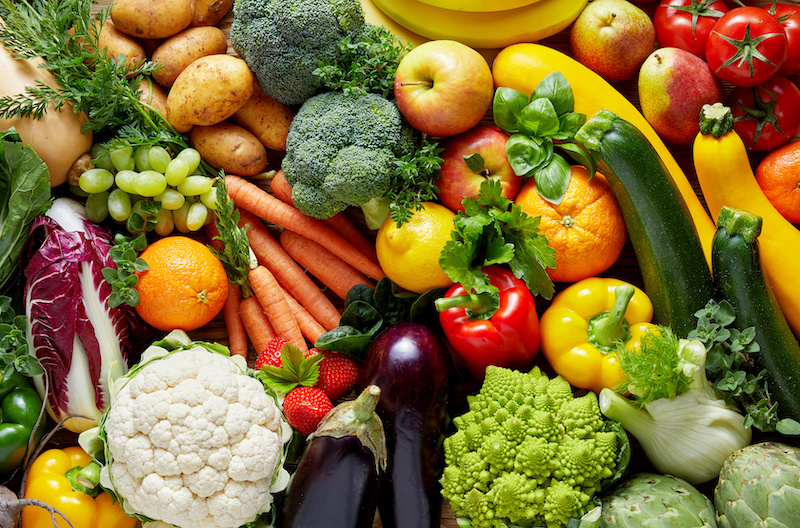
Gallbladder Removal –Life After Cholecystectomy
Gallbladder removal is a common treatment for gallstones, but it fundamentally changes your body’s digestive functioning and requires careful dietary management for the long term. Because the gallbladder acts as the storage chamber for bile, its removal means there is no longer a place to store bile as the liver is producing it, so a lesser amount is available at mealtimes. This means less bile overall is available for fat digestion, and a greater reliance on the bile that is injected directly into the intestine from the liver itself. This means your body will not be able to digest and absorb fats the same way it used to. Whilst this doesn’t mean you can no longer eat fats at all, it does mean making some changes to what you eat and how. Post-gallbladder removal, it is also important to support the liver, as the lack of gallbladder places additional burden on the liver to maintain health. Below are some tips for maintaining good health after cholecystectomy.
Be mindful of fat consumption
- Avoid high-fat meals, as your body will no longer be able to supply sufficient bile for proper digestion of high amounts of fat – that means no keto diet! A lower fat diet is a much better choice for optimal digestion. Aim for no more than 30% of your calories to come from fats. High fat foods will cause abdominal discomfort and digestive issues.
- When you do eat fats, focus on heart-healthy polyunsaturated and monounsaturated fats from sources such as extra virgin olive oil, hemp seed oil, nuts and seeds, oily fish, and avocados. We still need good quality sources of fatty foods in our diet for healthy cells, brain health, and for fat-soluble vitamins A, D, E, and K.
- Eat fats in small amounts throughout the day, instead of eating them all at once. This reduces how much bile is needed for proper digestion.
- Avoid saturated fatty acids, trans fats, and hydrogenated oils such as soybean and canola oil, which can be detrimental to liver health.
Eat plenty of fresh fruits and vegetables
- Aim for 5 or more serves of vegetables and 2 serves of fruits per day, choosing a variety of colours each day to maximise your nutrient intake.
- Fruits and vegetables provide an abundance of vitamins and minerals, as well as antioxidants which are crucial for optimal liver health.
- These foods also provide plenty of fibre to feed healthy gut microbiota. As discussed above, bile is important in maintaining a healthy microbiome, so providing additional support for healthy gut bacteria is important once your gallbladder has been removed.
Utilise bitters before meals
- Bitter foods and drinks encourage the liver to produce and secrete bile into the small intestine, ready to digest our food. Having bitters around 10-15 minutes before sitting down to eat can help ensure our digestive system is primed and ready for optimal digestion and absorption.
Try a small salad of dandelion greens or rocket as an appetiser or mix the juice of a lemon in 250ml of lukewarm water. Alternatively, herbal bitter remedies can be prescribed for a more potent effect.
Herbs and Supplements for Gallbladder Health
Herbs – Cholagogues
Cholagogues can be used to support healthy gallbladder function and prevent health issues, as well as to treat gallbladder conditions. However, they can be contraindicated, especially if there is a history of bile duct obstruction – always seek naturopathic guidance for a herbal prescription. Cholagogues include herbs such as globe artichoke and agrimony.
Herbs – Bitters
Bitters are a wonderful class of herbs that can be used to help with so many health issues. As the name suggests, these herbs contain lots of bitter principles and have a very strong bitter taste. It is the bitter taste of the herbs that gives them their therapeutic effect. Our bodies have bitter taste receptors not only on the tongue, but throughout the digestive system, increasing saliva, enzyme, and bile production. Bitter herbs activate these receptors and improve digestive function, and even shift the body into the parasympathetic nervous system to reduce issues associated with stress and anxiety. Gentian, wormwood, and globe artichoke are all well-known bitter herbs.
Herbs- Choleretics
Choleretics are herbs that stimulate the production of bile in the liver and promote its secretion into the gallbladder. They’re very commonly used for any conditions associated with the liver or gallbladder. Some commonly known choleretic herbs include milk thistle, calendula, and globe artichoke.
Lipase
Lipase is a type of enzyme that helps to break down fats, making them easier to absorb. Supplementing with additional lipase helps to ease the burden of reduced bile on the gastrointestinal tract after gallbladder removal, or when your gallbladder or liver health is impacting bile production and secretion.
Probiotics & Prebiotics
As discussed above, bile is important for a healthy microbiome. When insufficient bile is being produced, either due to gallbladder issues or removal, a good quality probiotic supplement can help support healthy microbial populations in the gut however prebiotics are more appropriate for many people as they are a food source for your own species. However, it is important to note that many over the counter probiotics available are poor quality and may not provide you with beneficial amounts of probiotics so it is best to seek naturopathic guidance on choosing a probiotic that will be of benefit to you.
References
Boyer, J. L. (2013). Bile formation and secretion. Comprehensive Physiology, 3.
Crawford, M. (2013). Biliary pain work-up and management in general practice. Australian Family Physician, 42(7). https://www.racgp.org.au/afp/2013/july/biliary-pain
Hechtman, L. (2012). Clinical naturopathic medicine. Elsevier Australia.
Housset, C., Chretien, Y., Debray, D., & Chignard, N. (2016). Functions of the Gallbladder. Comprehensive Physiology, 6.
Lammert, F., Gurusamy, K., Ko, C. W., Miquel, J.-F., Mendez-Sanchez, N., Portincasa, P., van Erpecum, K. J., Laarhoven, C. J., & Wang, D. Q. H. (2016). Gallstones. Nature Reviews Disease Primers, 2.
Maldonado-Valderrama, J., Wilde, P., Macierzanka, A., & Mackie, A. (2011). The role of bile salts in digestion. Advances in Colloid and Interface Science, 165(1), 36–46.
Man, S., Gao, Y., Lv, J., Tong, M., Yin, J., Wang, B., Ning, Y., & Li, L. (2022). Metabolically healthy obesity was significantly associated with increased risk of gallstones. European Journal of Endocrinology, 186(2), 275–283.
Tian, Y., Gui, W., Koo, I., Smith, P. B., Allman, E. L., Nichols, R. G., Liu, Q., & Patterson, A. D. (2020). The microbiome modulating activity of bile acids. Gut Microbes, 11(4)

